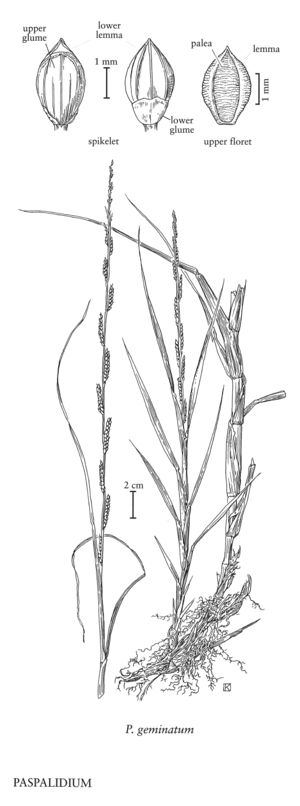Paspalidium geminatum
Plants perennial; rhizomatous. Culms 25-100 cm, erect. Leaves basal and cauline; sheaths glabrous, margins scarious, sparsely ciliate distally; ligules 0.5-1 mm, of hairs; blades flat to conduplicate, glabrous or scabrous. Panicles 10-30 cm; branches 5-15, 1-3.7 cm, erect, with more than 12 spikelets; terminal bristles 2.5-4 mm. Spikelets 2.2-3.2 mm, clearly overlapping. Lower glumes 0.8-1.2 mm, 1-3-veined, truncate; upper glumes and lower lemmas 2-2.4 mm, glabrous, 5-7-veined, acuminate; lower paleas 2-2.4 mm, scarious; upper lemmas and paleas 2-2.3 mm, rugose, stramineous to light-brown, lemma margins scarious, inrolled, clasping the paleas, lemma apices acuminate; anthers 1.2-1.5 mm. Caryopses about 1 mm in diameter, spheroidal, slightly flattened, yellow. 2n = 18, 54.
Distribution
Okla., Tex., La., Mo., Puerto Rico, Virgin Islands, Ala., Ga., S.C., Fla.
Discussion
Paspalidium geminatum grows in moist to wet, fresh to brackish areas. It is native to the southeastern United States, the West Indies, and tropical regions of the Americas.
Selected References
None.
Lower Taxa
"decumbent" is not a number.
